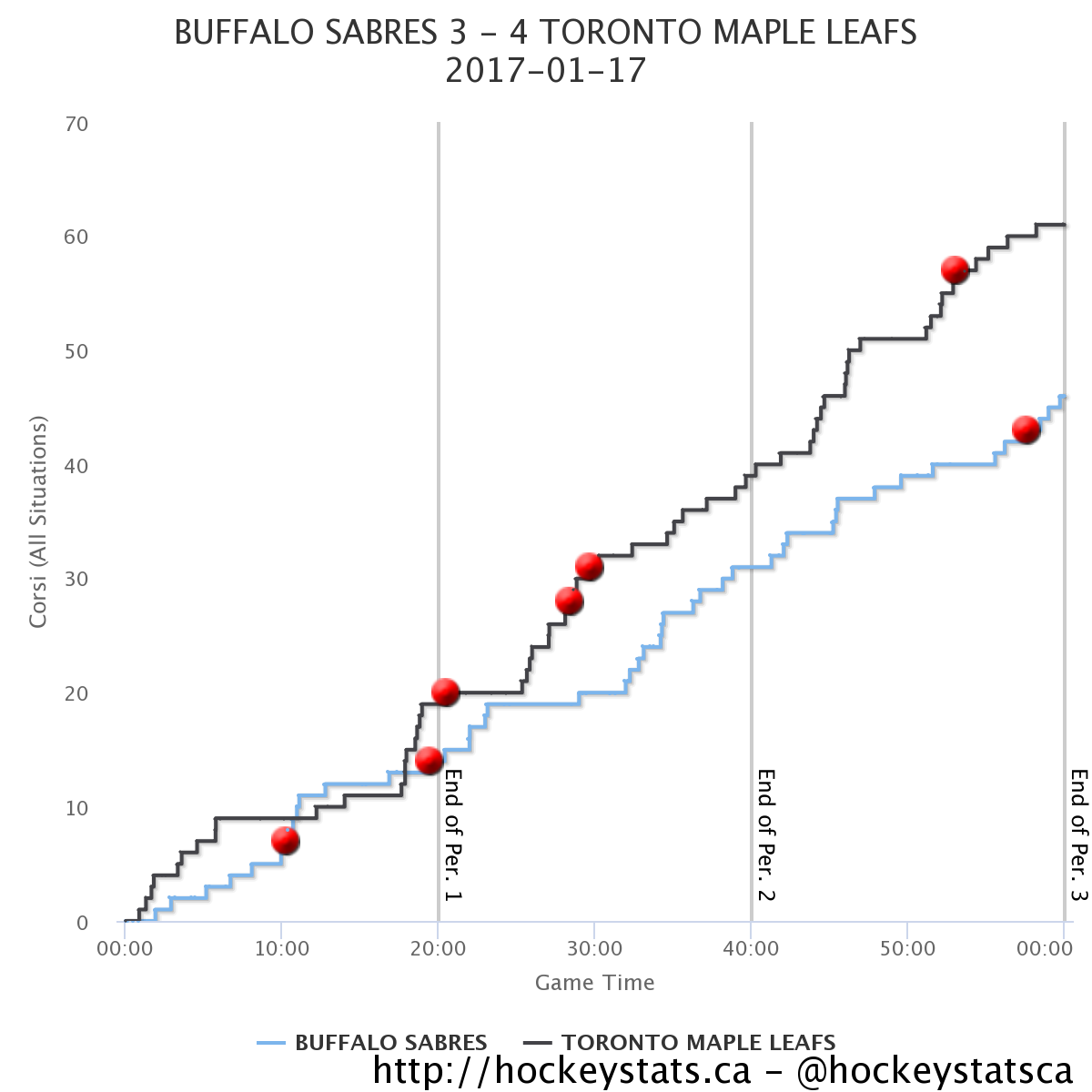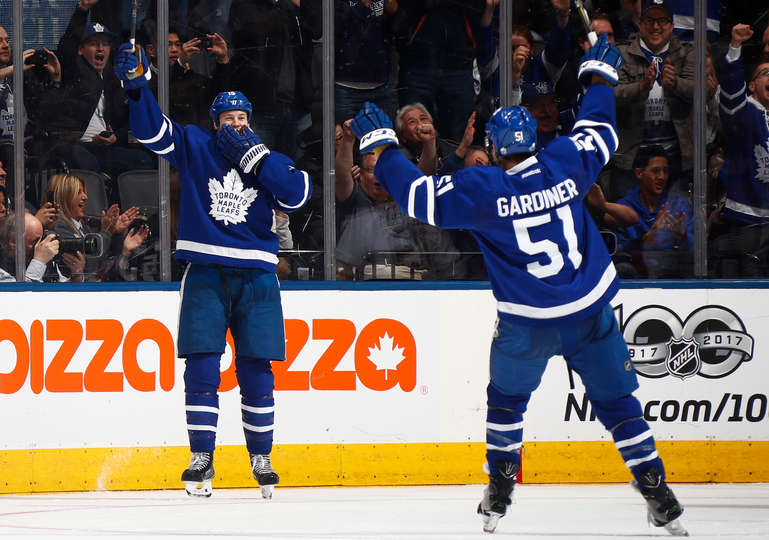The Toronto Maple Leafs overcame a 2-0 first-period deficit against the Buffalo Sabres on Tuesday night, scoring four consecutive goals en route to their ninth win in their last 11 games.
Your game in ten:
1) With the win, the Maple Leafs are now at 50 points in 42 games – a 98-point pace. Mike Babcock has stated many times over that his goal for the season is to collect six out of every ten points, broken down into five-game segments, which adds up to a 98-point season. His team has now caught up to that pace after a torrid 9-1-1 stretch in which they’ve scored 43 goals.
2) The bad news: Morgan Rielly could be out for a chunk of time and – if so – it will test an (already pretty thin) blue line group’s depth with the team’s first significant injury loss of the season. The somewhat-redeeming news: Jake Gardiner is playing the best hockey of his career and looks capable of filling the void reasonably well on the top pairing in the short term. He played over 29 minutes tonight after Rielly exited the game and took on the Jack Eichel assignment with aplomb, shadowing him closely and controlling 60% of the shot attempts in their head-to-head. He’s looking as confident as ever with and without the puck and he’s certainly got the skating ability and endurance to take on more minutes as the Leafs paper over the hole.
Matt Hunwick is next in line to move up a pairing on the left side, likely leaving him to play with Connor Carrick in the short term followed by Martin Marincin (he’s getting close to returning) and Roman Polak on the bottom pair (Polak and Marincin had solid possession numbers together in a fairly significant sample size last season). As much as Hunwick and Polak have been PK contributors who haven’t hurt the team badly from a goals perspective at 5v5, that is unquestionably a bottom four group that thins out very quickly, and the second pair appears to be a mismatch against a number of second lines around the league. Hunwick battles hard and contributes on the PK, but his consistent problem is that he can’t transition the puck quickly and cleanly enough into the hands of the Leafs’ forwards; the more minutes he plays higher up the order, it’s not hard to envision the potential issues. He played over 24 minutes tonight following the Rielly injury.
3) There is something particularly satisfying about a win in which a team gets contributions from all four lines. As much as Auston Matthews has been leading the way during this run, this is the opposite scenario to when the Leafs would get hot in the Phil Kessel era and so much of it had to do with a single line catching fire. The Leafs aren’t going to go 9-1-1 in their next 11, but when they have three lines as balanced as the Leafs’ top nine in terms of scoring potential, it’s unlikely they’re going to hit a major wall offensively.
4) Last season, the Leafs had one of the best powerplays in the league from the perspective of shot attempts generated (a testament to their structure and coaching) and one of the league’s worst in terms of scoring goals. It’s not altogether surprising that they’ve now shot up the league rankings on the man-advantage given the significant talent injection, but I doubt anyone saw it happening to this extent. Talent (they have two complete units) meets execution meets confidence, they’re absolutely on fire at the moment:
| DATE | OPP | PPG | PP OPP |
|---|---|---|---|
| 17 JAN '17 | BUF | 1 | 1 |
| 14 JAN '17 | OTT | 1 | 1 |
| 13 JAN '17 | NYR | 2 | 4 |
| 07 JAN '17 | MTL | 2 | 4 |
| 06 JAN '17 | NJD | 2 | 3 |
| 03 JAN '17 | WSH | 2 | 6 |
| 01 JAN '17 | DET | 0 | 2 |
| 29 DEC '16 | TBL | 1 | 5 |
| 28 DEC '16 | FLA | 1 | 3 |
| 23 DEC '16 | ARI | 1 | 1 |
| 22 DEC '16 | COL | 2 | 5 |
That’s six games in a row with a powerplay goal and 15 powerplay goals in their last 11 games (35 opportunities). They’ve gone one for one in their last two games after a four-game streak of two powerplay goals per outing.
Toronto is now second in the league in powerplay percentage (24.4), behind only Columbus.
5) The Leafs are far from playoff shoe-ins yet, but it’s getting safe to declare they’re a lot better than about 95% of people predicted, many of whom foresaw an Oilers-like return to the bottom again this season even despite the addition of some promising young talent. There has been a lot of debate online about when the rebuild actually started. For me, it’s simple: Brian Burke started the rebuild in 2008. It didn’t work out in his time here — and there were more false starts and faulty attempts to expedite the process along the way since — but that’s when the accumulation of young assets started. The leftover pieces are the “veterans” that are in the middle of their primes in JVR, Gardiner, Kadri – all three of whom are key contributors playing the best hockey of their NHL careers right now (those are “middle prime” players; we should also mention Rielly as an “early prime” player added during the Burke era). I said it on a Battle of Ontario podcast before the season – the Oilers, in some of those lean seasons after adding top draft talent to the big-club roster, did not have two top-four defencemen as good as Morgan Rielly and Jake Gardiner (both hitting and surpassing 300 games this season), and they did not have a prime-aged high-end 2C like Nazem Kadri able to play his kind of role for their team. They didn’t have a goalie as good as Frederik Andersen. Those are key pieces and vital differences.
6) This was the first time the Leafs have won a game not only while trailing by two but after trailing at all following the first period. This young group is slowly checking off the boxes and eliminating many of the hesitancies about their ability to win games despite their average age and collective experience level. They’ve given up multi-goal leads and won anyway (Detroit, Ottawa). They’ve won a couple of back-to-backs. They’ve won a couple of games with a backup goalie in net. And they’ve now overcome an early multi-goal deficit.
At this stage, we’re pretty confident in saying the Leafs can beat up on non-playoff teams a good amount of the time. Their three losses in their last 12 games have come against Anaheim, Montreal, and Washington, however. There are still some tests to pass before we can include the Leafs in the group of teams a level above “playoff bubble team.”
7) The Leafs looked well on their way to opening the scoring in this game and then the Frederik Andersen blooper happened. That clearly deflated the Leafs and encouraged the Sabres for the final 10 minutes or so of the first period. Leo Komarov’s early second-period goal got the ball rolling, much as he did when the Leafs were behind in the Centennial Classic entering the third, with a similar goal to boot – crashing the net and winning a battle in front. The soft chip down the ice to avoid an icing with a yawning cage tempting him late in the game said everything we need to know about Komarov as a “glue guy” on the team. A hockey club needs this kind of player to win tight games of importance.
8) The first results are in for what should be a decade-long Eichel vs. Matthews inner-division head-to-head rivalry. Matthews: five shots on goal, 58% CF in 13 5v5 minutes vs. Eichel, one vicious bar-down snipe. Eichel: six shots on goal, no points. Matthews also won 10 of 14 draws against Eichel (and a further three of four against O’Reilly, who is a great faceoff taker).
9) Thought this was maybe the most impressive game from Nikita Zaitsev this season from the standpoint of jumping up into the rush and getting involved offensively. He’s had to jump straight into the NHL in a top-pairing role, where he’s expected to take care of his own end first against the best players in the world night in and night out. It’s difficult to prouduce right away in that role, and yet a 40-point season still isn’t out of the question halfway through the season (he added a powerplay assist to his total tonight on JVR’s gorgeous goal). Given his deployment, that is about as much as the Leafs ever could’ve hoped for.
10) Nazem Kadri carried 56% of the shot attempts in his head to head against Ryan O’Reilly, picked up an assist, put four shots on goal and made a number of good defensive plays snuffing out danger. Chalk it up partially to his maturation as an individual and partially to the job Babcock has done developing him in the shutdown role, he’s constantly on the right side of the puck and digging in on his one-on-one battles. He’s a pleasure to watch right now as far as his play over 200 feet, and he continues to receive his just rewards offensively.
Game Highlights
Post-Game: Mike Babcock
All-Situations Shot Attempts





































